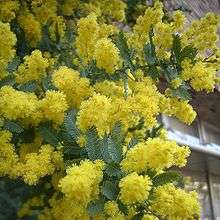Acacia baileyana
| Cootamundra wattle | |
|---|---|
 | |
| Scientific classification | |
| Kingdom: | Plantae |
| (unranked): | Angiosperms |
| (unranked): | Eudicots |
| (unranked): | Rosids |
| Order: | Fabales |
| Family: | Fabaceae |
| Genus: | Acacia |
| Species: | A. baileyana |
| Binomial name | |
| Acacia baileyana F.Muell.[1] | |
 | |
| Range of Acacia baileyana | |
| Synonyms | |
Acacia baileyana or Cootamundra wattle, is a shrub or tree in the genus Acacia. The scientific name of the species honours the botanist Frederick Manson Bailey. It is indigenous to a small area of southern New South Wales in Australia, but it has been widely planted in other Australian states and territories. In many areas of Victoria, it has become naturalised and is regarded as a weed, out-competing indigenous Victorian species.
Almost all wattles have cream to golden flowers. The small flowers are arranged in spherical to cylindrical inflorescences, with only the stamens prominent. Wattles have been extensively introduced into New Zealand.
Uses
A. baileyana is used in Europe in the cut flower industry. It is also used as food for bees in the production of honey.[3] American urban landscape designer Renée Gunter uses this plant in her South Los Angeles lawn as a drought-resistant alternative to thirstier plants.[4]
Less than 0.02% alkaloids were found in a chemical analysis of Acacia baileyana.[5]
Cultivation
This plant is adaptable and easy to grow. It has gained the Royal Horticultural Society's Award of Garden Merit.[6] Unfortunately it has an ability to naturalise (i.e. escape) into surrounding bushland. Also, it hybridises with some other wattles, notably the rare and endangered Sydney Basin species Acacia pubescens.
A prostrate weeping form is in cultivation. Its origin is unknown, but it itself is a popular garden plant, its cascading horizontal branches good for rockeries.[7] The fine foliage of the original Cootamundra wattle is grey-green, but a blue-purple foliaged form, known as 'Purpurea' is very popular.[8]
Use of colour
The colour Cootamundra Wattle is used currently by the Australian Capital Territory Fire Brigade as their colour scheme for firefighting appliances.
Gallery
-

Leaf and blossom
-

Fine detail of leaf
-

Leaf with fingers for scale
-

A. baileyana seeds
-

A. baileyana prostrate form in cultivation, Illawarra Grevillea Park, Bulli, NSW
References
- ↑ "Acacia baileyana". Australian Plant Name Index (APNI), IBIS database. Centre for Plant Biodiversity Research, Australian Government, Canberra. Retrieved 4 December 2012.
- ↑ "Acacia baileyana". LegumeWeb. International Legume Database & Information Service.
- ↑ "Uses of Australian Acacias". World Wide Wattle. 29 May 2013.
- ↑ Lodi News-Sentinel, Oct 12, 2007, Bettijane Levine, Los Angeles Times, Drought resistant plants, Retrieved Aug. 18,2007
- ↑ Hegnauer, Robert (1996). Caesalpinioideae und Mimosoideae. Springer. p. 336. ISBN 978-3-7643-5165-6.
- ↑ "Acacia baileyana AGM". Plant Selector. Royal Horticultural Society.
- ↑ Stewart 2001, p. 156
- ↑ Stewart 2001, p. 157
Cited text
- Stewart, Angus (2001). Gardening on the Wild Side. Sydney: ABC Books. ISBN 0-7333-0791-4.
External links
| Wikimedia Commons has media related to Cootamundra wattle. |
| Wikispecies has information related to: Acacia baileyana |